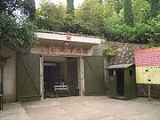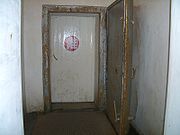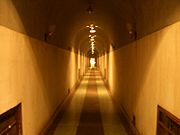
Underground Project 131
Encyclopedia

People's Republic of China
China , officially the People's Republic of China , is the most populous country in the world, with over 1.3 billion citizens. Located in East Asia, the country covers approximately 9.6 million square kilometres...
's Hubei
Hubei
' Hupeh) is a province in Central China. The name of the province means "north of the lake", referring to its position north of Lake Dongting...
province constructed in the late 1960s and the early 1970s to accommodate the Chinese military
People's Liberation Army
The People's Liberation Army is the unified military organization of all land, sea, strategic missile and air forces of the People's Republic of China. The PLA was established on August 1, 1927 — celebrated annually as "PLA Day" — as the military arm of the Communist Party of China...
command headquarters in case of a nuclear war. The facility was never fully completed or used, and is currently open to visitors as a tourist attraction.
Location
The Project 131 site is located in the Gaoqiao Township (高桥镇) of the Xian'an DistrictXian'an District
Xian'an District is a district of Hubei, China. It is under the administration of the prefecture-level city of Xianning.Xian'an District includes Xianning's central urban area and nearby villages.-Sights:At the "Underground Project 131" site, some 15 km southeast of Xianning urban area,...
of the Xianning
Xianning
Xianning is a prefecture-level city in China's Hubei province. It is known as the "City of Osmanthus".-Geography and climate:Xianning is located in southeastern Hubei province, just south of Wuhan, between the southern bank of the Yangtze River in the north and the Mufu Mountains in the south. It...
prefecture-level city
Prefecture-level city
A prefectural level city , prefectural city or prefectural level municipality is an administrative division of the People's Republic of China, ranking below a province and above a county in China's administrative structure. Prefectural level cities form the second level of the administrative...
in Hubei
Hubei
' Hupeh) is a province in Central China. The name of the province means "north of the lake", referring to its position north of Lake Dongting...
Province.
It is about 15 km east of Xianning urban area, and 80 km south of central Wuhan
Wuhan
Wuhan is the capital of Hubei province, People's Republic of China, and is the most populous city in Central China. It lies at the east of the Jianghan Plain, and the intersection of the middle reaches of the Yangtze and Han rivers...
.
History

Sino-Soviet split
In political science, the term Sino–Soviet split denotes the worsening of political and ideologic relations between the People's Republic of China and the Union of Soviet Socialist Republics during the Cold War...
in the late 1960s, the Chinese leaders deemed it prudent to construct a number of underground facilities to protect the country's population, military, as well as its command and control bodies, in case of a nuclear conflict. The best known of these facilities is Beijing
Beijing
Beijing , also known as Peking , is the capital of the People's Republic of China and one of the most populous cities in the world, with a population of 19,612,368 as of 2010. The city is the country's political, cultural, and educational center, and home to the headquarters for most of China's...
's Underground City
Underground City (Beijing)
The Underground City , also known as Dixia Cheng, is a bomb shelter comprising a network of tunnels located beneath Beijing, China, which has since been transformed into a tourist attraction. It has been called the Underground Great Wall because it was built for the purpose of military defense...
.
On January 31, 1969, a decision was made to construct an underground command headquarters for the country's military; the codename "131" for the project stems from this date (01-31, in the usual way of ordering dates in China). The PLA Chief of Staff, General Huang Yongsheng
Huang Yongsheng
Huang Yongsheng was a general of the China's People's Liberation Army.Huang Yongsheng was born in Xianning prefecture of Hubei province....
(黄永胜) himself was in charge of the construction.
A system of tunnels with meeting rooms, offices for the top commanders (including the Commander in Chief, Mao Zedong
Mao Zedong
Mao Zedong, also transliterated as Mao Tse-tung , and commonly referred to as Chairman Mao , was a Chinese Communist revolutionary, guerrilla warfare strategist, Marxist political philosopher, and leader of the Chinese Revolution...
and the second in command, Lin Biao
Lin Biao
Lin Biao was a major Chinese Communist military leader who was pivotal in the communist victory in the Chinese Civil War, especially in Northeastern China...
), communication center, etc, were constructed under one of the hills in the area, and villas for Mao Zedong and Lin Biao were built on the surface. However, after the death of Lin Biao
Lin Biao
Lin Biao was a major Chinese Communist military leader who was pivotal in the communist victory in the Chinese Civil War, especially in Northeastern China...
and the arrest of Huang Yongsheng in September 1971, the project was terminated, and it never saw its intended use. Neither Mao nor Lin Biao ever actually visited the site.
The tunnel system is reported to be 456 meters long, and has cost 130 million yuan
Renminbi
The Renminbi is the official currency of the People's Republic of China . Renminbi is legal tender in mainland China, but not in Hong Kong or Macau. It is issued by the People's Bank of China, the monetary authority of the PRC...
to construct.
Present state

Xianning
Xianning is a prefecture-level city in China's Hubei province. It is known as the "City of Osmanthus".-Geography and climate:Xianning is located in southeastern Hubei province, just south of Wuhan, between the southern bank of the Yangtze River in the north and the Mufu Mountains in the south. It...
, where it is located. An upscale hotel and conference facility was created above the ground, while the tunnel system was turned into a tourist attraction. At present (summer 2008), the underground rooms were mostly bare, decorated with signs describing the purported use of each room, an occasional piece of period furniture, and a few maps dealing with China's military history. There are also some exhibits (Mao badges
Chairman Mao badge
Chairman Mao badge is the name given to a type of pin badge displaying an image of Mao Zedong that was ubiquitous in the People's Republic of China during the early period of the Cultural Revolution, from 1966 to 1971. The term is also used for badges associated with Mao that do not actually have...
, posters, etc) in the pavilions on the surface. Unlike the pavilions and villas, the tunnel is still considered a military project and therefore closed to non-Chinese visitors (April 2009).
Huang Yongsheng
Huang Yongsheng
Huang Yongsheng was a general of the China's People's Liberation Army.Huang Yongsheng was born in Xianning prefecture of Hubei province....
's grave is also on the site.

